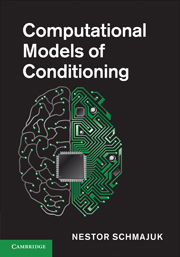Book contents
- Frontmatter
- Contents
- List of contributors
- Introduction
- 1 Evolution of attention in learning
- 2 The arguments of associations
- 3 The hybrid modeling approach to conditioning
- 4 Within-compound associations: models and data
- 5 Associative modulation of US processing: implications for understanding of habituation
- 6 Attention, associations, and configurations in conditioning
- 7 Computer simulation of the cerebellum
- 8 The operant/respondent distinction: a computational neural-network analysis
- Index
- References
6 - Attention, associations, and configurations in conditioning
Published online by Cambridge University Press: 10 January 2011
- Frontmatter
- Contents
- List of contributors
- Introduction
- 1 Evolution of attention in learning
- 2 The arguments of associations
- 3 The hybrid modeling approach to conditioning
- 4 Within-compound associations: models and data
- 5 Associative modulation of US processing: implications for understanding of habituation
- 6 Attention, associations, and configurations in conditioning
- 7 Computer simulation of the cerebellum
- 8 The operant/respondent distinction: a computational neural-network analysis
- Index
- References
Summary
Abstract
This chapter describes a number of computational mechanisms (associations, attention, and configuration) that first seemed necessary to explain a small number of conditioning results and then proved able to account for a large part of the extensive body of conditioning data. We first present a neural-network theory (Schmajuk, Lam, & Gray, 1996), which includes attentional and associative mechanisms, and apply it to the description of brain activity in the amygdala, anterior cingulate cortex, dorsolateral prefrontal cortex (PFC) and insula, compound conditioning with different initial associative values, the accelerating effect of the extinction of the conditioned excitor on the conditioning of its corresponding conditioned inhibitor, super latent inhibition, recovery and absence of recovery from blocking, latent inhibition–overshadowing synergism and antagonism, summation tests in the context of extinction, and spontaneous recovery. Then we describe another neural network (Schmajuk & Di Carlo, 1992; Schmajuk, Lamoureux, & Holland, 1998) that includes configural mechanisms, and apply it to the description of response form in occasion setting. Finally, we show how the combination of attentional, associative, and configural mechanisms (Schmajuk & Kutlu, 2010) describes the effect of additivity pretraining and posttraining on blocking in causal learning.
Schmajuk, Lam, and Gray's (1996) attentional–associative model
Schmajuk et al. (1996) and Schmajuk and Larrauri (2006) proposed a neural-network model (SLG model) of classical conditioning. The SLG model shares properties with other associability models, including equations that portray behavior on a moment-to-moment basis (Grossberg, 1975; Wagner, 1981), the attentional control of the formation of CS–US associations (Pearce & Hall, 1980), the competition among CSs to become associated with the US (Rescorla & Wagner, 1972) or other CSs (Schmajuk & Moore, 1988), and the combination of attention and competition (Wagner, 1979).
- Type
- Chapter
- Information
- Computational Models of Conditioning , pp. 186 - 218Publisher: Cambridge University PressPrint publication year: 2010



